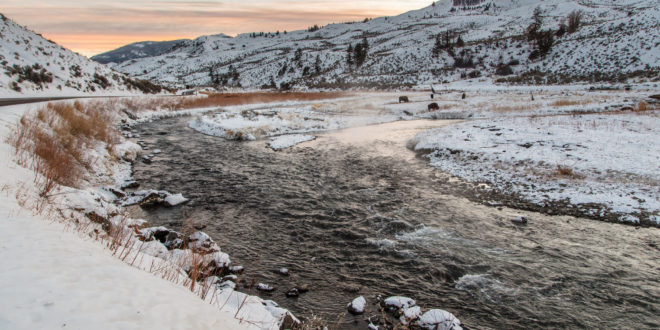Is there anything better than stripping down to your swimsuit outside in the dead of winter to take a soak in Yellowstone’s Boiling River?
Maybe there is, but on a winter day along the Gardner River, it’s hard to think of any.
Diehards will say winter is the best time to hit Boiling River, the legal, natural warm-water swimming hole between Mammoth Hot Springs and the North Entrance at Gardiner. There’s none of the summer hordes, for one thing. The other soakers are mellow, respectful of the scenic natural beauty. And you’re likely to run into someone you know if you’re from within about 300 miles of Yellowstone.
The water levels and temps are better, too. The hot water running down from Mammoth Hot Spring enters the Gardner River, where, with winter’s lower streamflow on the Gardner, you’ll find a higher proportion of hot water to cold.
So here’s the trick to winter hotpotting. Wear your swimsuit under your clothes. Get in fast. Get out fast. Stack up your clothes in the order you’re going to put them back on. If it’s really cold, wear a hat. And don’t forget to bring a pair of shoes to wear in the water. The rocks are hard and slippery.
Once you’re all the way in and settled in a spot that’s just right, say ‘Ahhhh….” With your nose just above river level, watch the water flow by. Observe how near the rocks have a rime of ice, while you are cozy in hot, flowing water. Maybe you’ll see elk far across the way on the flanks of Mount Everts or hear the “Rawk!” of a raven overhead. Water ouzels, also known as dippers, a small, dark bird that bops along the river and sometimes dives in, are a common sight along the Gardner all year long.
“Hot River” was the name for the place early Yellowstone interpreters tried to apply because the water is not actually boiling, according to Yellowstone National Park Historian Lee Whittlesey. But “Boiling River” stuck.
The Boiling River flows into the Gardner River about halfway between the town of Gardiner and Mammoth Hot Springs. Park regulations forbid swimming in hot springs in Yellowstone. The water temperatures can fluctuate dangerously and human activity can damage fragile thermal features.
But in some park locations, where hot water meets the cold waters of a regular, free-flowing river or stream, it is allowable to swim in the “regular” river. Where hot water meets cold is the sweet spot of hotpotting.
Hot springs facts
The flow of hot water was measured by early thermal researchers E.T. Allen and Arthur Day in the 1930s, according to Whittlesey. They published a work, “Hot Springs of the Yellowstone National Park” in 1935 that is one of “bedrock pieces of science,” Whittlesey said.
Boiling River, where it emerges above the Gardner River, is 145 yards long, six to eight feet wide and about two feet deep.
Allen and Day calculated the flow at 21.7 cubic feet per second. They also estimated the hot water carries 103 tons of dissolved material, such as travertine limestone, per day, Whittlesey said.
If you go
Boiling River is open during daylight hours and closes at dusk each day. The road between Gardiner and Mammoth is open year-round. Swimming is prohibited and the area is closed in the spring during times of high water. And Boiling River is a “swim at your own risk” site. There are no lifeguards on duty. And as a site within Yellowstone National Park, entrance fees apply.
 Yellowstone Insider Your Complete Guide to America's First National Park
Yellowstone Insider Your Complete Guide to America's First National Park





